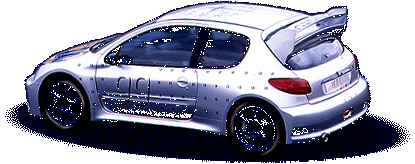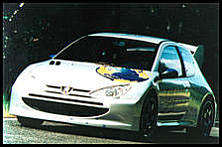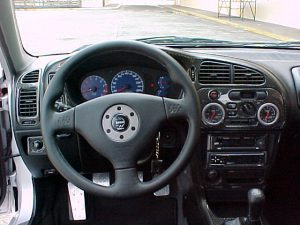Peugeot 206 WRC history and technical infos
Peugeot is finally back in the chase for the World Rally Championship title with a car that has real chances of winning, the 206 WRC. After a total domination of the WRC world between 1984 and 1986 with the GroupB car 205 turbo 16 and the 12 year absence from the world scene that followed, the company decided the make a fabulous, but expected, comeback. The 205 turbo 16 car has won 2 WRC titles (1985 and 1986) and scored a total of 21 WRC wins with drivers such as Juha Kankkunen, Ari Vatanen and Timo Salonen (note the preference for Finnish drivers). Peugeot have been very active, during the three year period (since 1995), that preceded their comeback developing the 306 front wheel drive 2lt class kit car that successfully competed in European championships (the car has won two French championship titles in 1996 and 1997). The 306 Maxi version (which is a 2lt kit car, picture here) has even taken part in tarmac based WRC races (Corsica, Catalunya, Monte Carlo and San Remo) with great success putting many WRC class cars under threat. All this to say that the 12 year absence of Peugeot from World Rallying has not been a period of inactivity. Most of the 205 turbo 16 team members and technical stuff are still with Peugeot. Not surprisingly the person responsible for the 206 WRC project, Jean Pierre Nicolas, was driving the 205T16 15 years ago. The other members of the project management at Peugeot Sport are François Xavier Delfosse, project leader, Michel Nadan, chief engineer (and ex-TTE engineer), and Xavier Carlotti.

The 206 WRC prototype in late 1998
Like most WRC class cars the Peugeot 206 WRC is based on a large scale production model. All resemblance and similarity stops here however. Whatever Peugeot or anyone else tells you the 206 WRC has no parts in common with the corresponding production model apart from light housings and door handles (and even those parts are probably lightened..).
The FIA regulations allow extensive modifications to WRC class cars that make them radically different from the base model. In the 206 WRC’s case the car uses now a full time 4 wheel drive transmission, its engine is turbocharged and has no equivalent in Peugeot’s showrooms. Unlike the old GroupB days when Peugeot surprised all the other manufacturers by combining each one’s best ideas into one car, the 205T16, (4WD and turbo from Audi, mid-engined space frame from Lancia, turbo charging from Renault and others, transversal engine and gearbox etc) and made a real winner, these days what differentiates WRC class cars is how elaborate their onboard electronics are. Onboard electronic systems include engine management, differential locking management, suspension management etc. That’s the secret of a successful WRC class car. In this field both the data disclosed by Peugeot as well as the performance of the car during the 1999 season were very encouraging regarding the future of the 206 WRC.
The new Peugeot holds yet a lot of secrets concerning details of the 206 WRC project. One thing is for sure, it has looks to die for and is by far the most beautiful WRC contender. The car’s body was designed by Gerard Welter and Murat Gunak (ex-Mercedes Benz designer).
Let’s review now some of the technical characteristics that have been disclosed by Peugeot.
The 206 WRC follows the new wave (fashion?) in rally car design in that it is, like the Toyota Corolla and Ford Focus, very compact. The car has a lot more in common with its illustrious predecessor, the 205T16, than with the commercial Peugeot 206 range. Its engine block, for instance (made in aluminum die-cast), is the same as the one used in the 205T16 15 years ago! Most other engine parts in the new car are direct successors to their equivalent in the 205T16. The engine displacement is compliant to FIA WRC car regulations i.e. less than 2lt (1997cm3 to be precise). The 205T16′ engine displacement was 1775 cm3 at the time GroupB regulations had set a maximum of 1.8lt displacement for turbocharged engines. You can review the disclosed specs of the new car here.
The suspension layout has to comply with the FIA regulations and thus not be radically different, in its principle, than the one fitted on the commercial, basis, model. The 206 WRC uses a McPherson suspension layout all around with lower wishbones. McPherson struts have the advantage of being rather compact and not necessitate a large volume around them for their fitting thus allowing more space to fit other parts of the car. Peugeot is the only manufacturer involved in the World Championship to build its own dampers and this approach has apparently proven the good one. However the budget required to develop, test and implement in-house dampers only comes to prove how significant is the underlining financial support of the Peugeot team. A final world on the 206 WRC suspension to point out that the car was the first, in late 2002, to introduce a hydro-electronic anti-roll control effectively suppressing anti-roll suspension bars and the related weight.
The 206 WRC architecture favors versatility over stability. The car’s wheelbase, although sufficient at 2468 mm, is not one of the biggest in WRC. Only the Seat Cordoba WRC car has a smaller wheelbase (at 2443mm). All other WRC contenders display a wheelbase above 2500mm. Note however that, following the current trend in rallying, the car does have its wheels at each corner, no overhangs whatsoever, in order to reduce inertia to the minimum and help its dynamic characteristics. According to the latest rumors on the evolution 2 of the 206 WRC, due to appear in 2001, the new car will have a longer wheelbase and this will be the object of a new homologation sheet by Peugeot to the FIA.
The transmission layout and implementation, according to the latest data, was initially based on a central hydro-electronically controlled differential while the front and rear ones were using mechanical self-locking types. Starting with the 1999 San Remo rally the front mechanical differential was replaced by a hydro-electronically controlled one. That’s to say the 206 WRC used a differential layout similar to that found in the Toyota Corolla WRC which went out of production by late 1999 and consequently its development was halted. Ford in the Focus WRC car, Subaru in the latest Impreza WRC and Mitsubishi in the Lancer Evolution VI, only since the 1999 San Remo rally for the latter, use hydro-electronically controlled differentials all around. The Peugeot team targets the use of actively controlled differentials all around for the first time at the 2000 Catalunya rally in Spain. One can count on Peugeot when it comes to electronically controlled differentials. The company has already proved it masters 2 wheel drive drivetrains in the 306 Maxi kit car which, in its “works” layout, already used an electronically managed differential. A lot of this experience has been beneficial to the development of the 206 WRC although it is not directly applicable. In the 306 Maxi kit car, when wheel spin is detected, the engine management stopped firing 1, 2 or even 3 cylinders until wheel spin stopped. A similar mechanism would not be adequate for a 4 wheel drive car where differential management is much more complex and traction is always superior to that of a 2wd car. Peugeot, like most other WRC car manufacturers, use hydro-electronic differentials in the 206 WRC that have less impact on the engine’s output when wheels spin, thus reducing the power loss, but act directly on the spinning axle and, progressively lock it, until the torque distribution is ideal.
Note that the Peugeot 206 WRC slides a lot less around corners than other WRC contenders and is, thus, less impressive to watch but far more efficient and fast than other cars that are driven with constant trajectory corrections. This behavior is due to the extreme care taken in the design of the car’s suspension and drivetrain and, apart from preserving the tires, has made the 206 WRC very hard to beat on any surface.
In the Peugeot the gearbox (manufactured by the English specialist X-Trac) is longitudinally mounted at the rear of the engine, in an almost central position although the car’s engine is transversally mounted at the front. This is a surprising mechanical architecture that has rarely been implemented before and is nowadays only to be found on the Ford Focus WRC. The advantages of this implementation are obvious:
- Better mass distribution
- Lower inertia in the front axle
- Easy access to the gearbox (usually one front suspension has to be dismounted to provide access to a transversally mounted gearbox)
- Direct torque transfer to the central differential and rear axle
- Possibility to use larger, stronger gearboxes and gears (there’s more space available for their implementation)
Mechanically though, mounting the gearbox longitudinally when the engine is mounted transversally is very complex and can lead to mechanical failures. The numerous transmission problems the 206 WRC cars had during the 1999 season witness the company’s efforts to render the setup more reliable. Starting with the 2000 season, the 206 WRC sequential gearbox is operated through small, steering wheel mounted, levers just like in the Subaru Impreza WRC. By the middle of the 2001 season the progress made in the electronic engine management system was such that, in combination with a new smaller turbocharger, usable torque was available through a very wide range of engine rev speeds. Due to the improved engine torque availability Peugeot was the first manufacturer to start using 5 speed gearboxes instead of the more classic 6 speed ones. Reliability was improved as 5 speed boxes can use larger, stronger gears while heat can be maintained to reasonable levels. Note that in the 206 WRC all the lubrification is performed by the same oil which is used in the engine, gearbox, differentials and power assisted steering. All the oil is collected to a single, multi-channel, water to oil heat exchanger for cooling and is then redistributed to the different mechanical parts.

A Peugeot 206 WRC early prototype
The 206 WRC project had already fixed a few important milestones in the beginning of its development. The project started in January 1998. The Peugeot 206 commercial line was launched, in France, by September 1998. Between February and March 1999 Peugeot developed the prototype that would allow them to homologate the car with the FIA. By April 1999 the company had to manufacture the 20 cars that will allow the FIA to produce its homologation sheet. The first official race for the car was to be the Tour de Corse rally in May 1999 (the 205T16 also debuted its rally career at the Corsican event, simple coincidence?). In the months that preceded the official re-entry of a Peugeot 4WD car in the WRC a certain number of prototypes were destroyed while testing. Gilles Panizzi, one of the official 206 WRC drivers, had a particularly impressive accident in Corsica and the related images and movies were largely circulated on the Internet. Luckily, although the car was completely destroyed, Gilles came out unhurt.
The driving position of Peugeot’s new contender must be one of the highest sitting ones of all WRC cars. In order to fit the transmission tunnel, which is of course not part of the base model, Peugeot engineers had to elevate the driver’s seat quite a bit. The car’s engine has been placed as close as possible to the center of the car (WRC car regulations allow a manufacturer to move the engine by 20mm as compared to the base car) and makes the cabin even more cramped. From a driver’s point of view, however, this is more of an advantage than anything else since the relatively high sited position allows for better visibility.
The 206 WRC being a World Rally Car you cannot, of course, buy it at your local Peugeot dealer. The company will only manufacture competition cars since there’s no longer a need to produce street versions to get the FIA homologation. That’s one of the true downsides of the new regulations. Back in the GroupA class days a manufacturer had to produce 2500 samples of a car resembling the competition car to get it to race. Even in the old GroupB car days 200 sample cars had to be produced. The FIA wanted to draw as many manufacturers as possible in the WRC and thus avoided to scare them off with the substantial financial investment that’s involved in producing street versions of their rally cars. While the new regulations did manage to draw new manufacturers in the WRC (Hyundai, Seat, Peugeot, Skoda, …) they shuttered the dreams of people like you and me to get our hands on cars that had something (well not that much but even so) in common with those involved in racing.
One might think that Peugeot have nothing to prove anymore in World Rallying. I would say their situation is a bit ambiguous. A pointer that allows to better understand their status is that they very conservatively announced that the 206 WRC would compete in 1999 to finish its setting up and would head for the WRC manufacturer’s title only in 2000. The mission was a complete success with the company not only fulfilling its promise to win the manufacturer’s title in 2000, they did so and brilliantly, but also pushing Marcus Grönholm to the highest step in the WRC hierarchy and allowing him to win the 2000 WRC championship.
Consider that the past must have also been a big burden for the Peugeot Talbot Sport (PTS) team. They had to prove themselves in an environment which is much more competitive than it used to be back in the old GroupB days.
The PTS drivers for the 1999 season had been announced quite early. The 206 WRC was driven by François Delecour, Gilles Panizzi and Marcus Grönholm. François, the most experienced among them, masters most surfaces and already has extensive experience of 4WD turbocharged cars (drove for Ford the Sierra and Escort Cosworth) as does Marcus (drove the Toyota Celica GTFour and Corolla WRC). Marcus is more keen of slippery surfaces though (gravel and snow) and is not known as a tarmac specialist. Gilles is a very gifted tarmac driver with little experience of 4WD turbocharged cars. He’s very willing to learn the tricks of slippery road racing and has even taken part in the 1998 Finnish rally driving a “small” GroupN Peugeot 106 just to get the feeling of gravel racing. This is very admirable as not a lot of drivers of his talent would be willing to undergo the same experience. Note that both François and Gilles were part of the PTS team for 3 years prior to joining the 206 WRC project. François was dismissed from the team in late 2000, for obscure reasons, and joined his old mates at Ford. Peugeot hired Didier Auriol, Seat refugee and former World Champion, to replace him only to fire him too a year later.
All in all Peugeot used a very wise and conservative approach to carry out their WRC comeback. They spent 4 years restructuring the team, getting to know their drivers, engineers and managers when they were working on the 306 Maxi kit car. The company now has a very capable team and their car has already proved its winning potential.
The 206 WRC car scored its first win on February the 5th 2000 at the Casinos da PĂłvoa rally in Portugal driven by Adruzilo Lopes. The car scored its first WRC win in 2000 Swedish rally driven by Marcus Grönholm. It won the WRC manufacturer’s title that same season.

